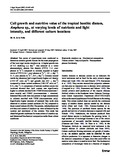Cell growth and nutritive value of the tropical benthic diatom, Amphora sp., at varying levels of nutrients and light intensity, and different culture locations

View/Open
Date
2007Author
Page views
351Metadata
Show full item recordCited times in Scopus
81 readers on Mendeley
Share
Abstract
Two series of experiments were conducted to determine suitable growth factors for the mass propagation of the local algal isolate Amphora sp. A higher growth rate of 0.2 doubling (μ) day-1 was attained at a lower photosynthetic photon flux density (PPFD; 11.4 μmol photon m-2s-1) compared to cultures exposed to higher levels of PPFD (16.1 μmol photon m-2s-1, −0.1 μ day -1; 31.3 μmol photon m-2s-1, 0.0 μ day-1). Cultures located inside the laboratory had a significantly higher cell density (133 × 104 cells cm-2) and growth rate (0.3 μ day−1) compared to those located outdoors (100 × 104 cells cm-2, 0.2 μ day-1). A comparison of nutrient medium across two locations showed that lipid content was significantly higher in cultures enriched with F/2MTM (macronutrients + trace metals) and F/2MV (macronutrients + vitamins). Saturated fatty acids were also present in high concentrations in cultures enriched with F/2M (macronutrients only). Significantly higher amounts of saturated fatty acids were observed in cultures located outdoors (33.1%) compared to those located indoors (26.6%). The protein, carbohydrates and n-6 fatty acid content of Amphora sp. were influenced by the location and enrichment of the cultures. This study has identified growth conditions for mass culture of Amphora sp. and determined biochemical composition under those culture conditions.
Suggested Citation
de la Peña, M. R. (2007). Cell growth and nutritive value of the tropical benthic diatom, Amphora sp., at varying levels of nutrients and light intensity, and different culture locations. Journal of Applied Phycology , 19(6), 647-655. https://doi.org/10.1007/s10811-007-9189-0
Subject
Collections
- AQD Journal Articles [1248]
